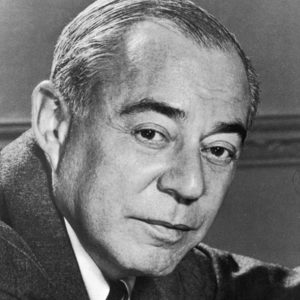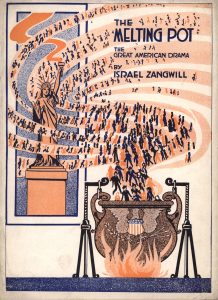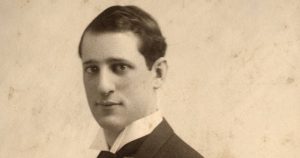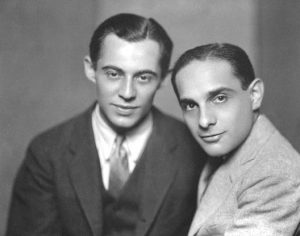
We mark the death on December 30, 1979 – 40 years ago today – of the American composer Richard Rodgers at the age of 77. A life-long New Yorker, Rodgers was one of the most prolific American composers of all time, having written the music for – among other works – 43 Broadway musicals and over 900 songs. He is one of only two people to have scored an EGOT, meaning that he received an Emmy, a GRAMMY® (three of them, actually), an Oscar, a Tony (seven in all) along with a Pulitzer Prize (for the musical South Pacific, in 1950). (For our information, the only other person to have won all five awards was the phenomenal Marvin Hamlisch, 1944-2012.)
We will discuss Maestro Rodgers as an exemplar of the “American crucible” in a bit. But first, permit me some first-person information that, believe it or not, will eventually have a direct bearing on this post.
An observation: we all do things to our bodies when we are young (or relatively young) that, in retrospect, we should not have. For me it was fairly serious weightlifting, which I took up in my early 30’s and continued until I was 51.
Regarding weightlifting, the truism applies: our joints give out long before our muscles do. By the time I had to quit, I had wrecked both of my shoulders, though for years I did my level best to ignore the damage and the chronic pain that went with it. 3½ years ago I finally bit the bullet and had my right shoulder repaired: all four of the tendons that make up my rotator cuff were torn and had to be reconnected, as was my bicipital tendon; rather severe damage to my humerus bone (the large bone in my upper arm) necessitated a cadaver bone graft as well. On December 4 of this year – 26 days ago – I had my left shoulder repaired. Again, all four tendons of the rotator cuff had to be reattached and the bicipital tendon repaired, though thankfully there was no bone damage to deal with this time around.

Advice: if you can avoid such surgery, do so. It is painful and the recovery is slow. For the first two weeks after the surgery I could not drive, shower, or type (which means, for me, I could not work). Given my inability to do anything else, I did something I hadn’t done since my last shoulder surgery, and that was binge-watch Netflix, Amazon, and Hulu television shows.
Among the shows I consumed was Amazon’s/Ridley Scott’s The Man in the High Castle, a series loosely based on a book of the same title by Philip K. Dick. (Dick’s book Do Androids Dream of Electric Sheep? was the basis for Ridley Scott’s 1982 classic Blade Runner.) The Man in the High Castle takes place between 1962 and 1964. The basic premise is that in a parallel universe, the United States lost World War Two and as a result, the eastern and midwestern states are presently part of the “Greater Nazi Reich” and the western states constitute the “Japanese Pacific States”, with the Rocky Mountains acting as a Neutral Zone between them.
The opening credits are chilling. Black and white imagery depicts a destroyed United States Capitol Building (Washington, D.C. was nuked by the Germans in 1945), and various other American monuments – Mt. Rushmore, the Statue of Liberty, the Golden Gate Bridge, etc. – despoiled by the occupiers. The predominately Nazi imagery depicted during the credits is accompanied by a breathy rendition (think Marilyn Monroe singing Happy Birthday to J.F.K.) of the song Edelweiss, with its now sinister closing line, “bless my homeland forever.”
The choice of Edelweiss as the theme music for the credits was both a brilliant stroke and is, at the same time, tremendously – if probably inadvertently – ironic. Brilliant because “edelweiss” (which means, literally, “noble white”) is the German language word for a white alpine flower that grows in the Austrian alps. Used in this context, the song Edelweiss addresses the white Aryanization of most of North America; at the same time, it also speaks to Austria (the birthplace of Adolph Hitler) and the Bavarian/Austrian Alps (where Hitler maintained his mountainside retreat called the Obersalzberg, so named because of its proximity to the same salt mountains that gave the nearby city of Salzburg its name).
It was in the city of Salzburg that lived the von Trapp family, that family of singers immortalized by the Broadway musical The Sound of Music (of 1959) and the movie of the same title (of 1965). The song Edelweiss comes from The Sound of Music, and there it is, the awesome irony created by using Edelweiss to represent the Nazi takeover of North America during the opening credits of The Man in the High Castle. That irony? The words to the song were written by the half-Jewish Oscar Hammerstein II (1895-1960) and its music by the 100% Jewish Richard Rodgers, whose father had changed the family name from the Russian Rogazinsky to Rodgers.
Ain’t that tasty treat!
The Melting Pot
The “Melting Pot”. It’s a phrase we learned in elementary school as a metaphor for the presumed “fusion” of races, nationalities, ethnicities, and cultures that together constitute the “American Nation”.

While the actual phrase “melting pot” only came into general use after 1908 thanks to the production of a play of the same name written by a London-born playwright named Israel Zangwill, the concept of America as a social “crucible” or “smelting pot” or “fusion” goes back to the eighteenth century.
Most Americans take pride in our national myth: that as a nation of immigrants drawn to the freedom and opportunity offered by this “new world”, we have become fused together into a whole greater than its parts. Of course, this national myth generally excludes those folks who were already here – a population of native North Americans estimated to have been as high as eighteen million in 1600, before their near-extermination began – as well as the Africans who were brought here by the lowest of human traffickers to suffer unspeakable abuse and servitude for generation upon generation. Whether modern America truly is a melting pot or merely a nation of tribes united only by a shared desire for personal freedom and economic opportunity we’ll leave for another time.
That’s because when it comes to music, the American melting pot is no myth, but rather, a genuine crucible into which various African and European musical traditions have been forged into entirely new, utterly American bodies of music. West African rhythmic, melodic, and performance traditions, when melded with Protestant church hymns, European harmonic practice and instruments facilitated the creation of the musical genres of spiritual, blues, ragtime, jazz, and rock ‘n’ roll. Irish and Scottish folk music blended with West African rhythmic practice and the Black American spiritual tradition to precipitate the emergence of “Hillbilly music” – now called “Country music” – during the first decades of the twentieth century. And the songs of the American musical and vaudeville theaters, when merged with the wit and urbanity of the early twentieth century New York literary scene and the music of Black America together created the so-called “Great American Songbook.”
The “Great American Songbook” – the “American standards” that make up the canon of American popular songs, theater songs, and movie songs – was created during the first half of the twentieth century by a disproportionate number of American Jews – like Richard Rodgers – working primarily out of New York City. The reasons behind this ethnic preponderance are many. Between 1880 and 1914 some 2,000,000 Eastern European Jews settled in the United States, primarily clustered in and around New York. The entertainment industry centered in New York was one of the few open to Jews at the time, and as more Jews became involved in vaudeville, musical theater, music publishing, and the nascent film, recording, and radio industries, the easier it became for other Jews to become involved as well. Because traditional Eastern European dance music (“Klezmer”) and cantorial chant has at least as much in common with West African music as it does with Western European music, many Jewish musicians had a greater simpatico with the music of Black America than did their Anglo colleagues, a simpatico that found its way directly into their songs.
Now please: this is not to say that the American Song Book was created entirely by Jews; to even imply so would be to overlook the seminal contributions of such composers as Duke Ellington, Cole Porter, Thomas (“Fats”) Waller, Hoagy Carmichael, Richard Whiting, Cy Coleman, Ray Henderson, Nacio Herb Brown, Isham Jones, Jimmy McHugh, Johnny Mercer and Vincent Youmans. But just as a list of the greatest jazz musicians from 1920-1950 will feature primarily black artists, so the corresponding list of greatest American songwriters and theater composers from 1920-1950 will be dominated by Jewish-born composers, composers like:
- Jerome Kern (born in Manhattan, 1885-1945);
- Irving Berlin (the son of a cantor, born Israel Isidore Beilin in today’s Belarus, 1888-1989; Berlin’s songs define American song and include White Christmas, Easter Parade, and God Bless America);
- George Gershwin (born Jacob Bruskin Gershowitz in Brooklyn, N.Y.; 1898-1937);
- Kurt Weill (the son of a cantor, born in Dessau, Germany; 1900-1950);
- Arthur Schwartz (born in Brooklyn, N.Y.; 1900-1984);
- Frederick Loewe (born in Berlin, Germany; 1901-1988) who, with lyricist Alan J. Lerner (born in Manhattan, 1918-1986), wrote the music for My Fair Lady, Camelot, and the movie musical Gigi (1958), which won 9 Academy Awards, including Best Picture;
- Vernon Duke (born Vladimir Dukelsky in Pskoff, Russia; 1903-1969);
- Harold Arlen (the son of a cantor, born Hyman Arluck in Buffalo, N.Y.; 1905-1986; Arlen’s Somewhere Over the Rainbow might just be the greatest American song of all time);
- Frank Loesser (born in New York City; 1910-1969; Loesser’s shows include Guys and Dolls and How to Succeed in Business Without Really Trying).
The list goes on (and on) and includes Leonard Bernstein (1918-1990), Steven Sondheim (born 1930), Jerry Herman (1931-2019; he passed away last week on December 26th), and the previously mentioned Marvin Hamlisch.

(Okay, pardon-moi but the brother Gumm deserve mention as well, if only because we all know their music but not their names. Harry Gumm – born Aaron Gumbinsky – was born to Polish Jewish immigrants in 1872 in Detroit; he died in New York City in 1946. Writing under the name “Harry von Tilzer”, he composed an astonishing 8,000-plus songs, of which over 2,000 were published. It is estimated that several hundred million copies of his songs were sold during his lifetime. Among those songs are A Bird in a Gilded Cage, Wait Till the Sun Shines Nellie; and I want a Girl Just Like the Girl that Married Dear Old Dad. Prolific though he was, Harry von Tilzer would still be remembered today had he never written a single song, because it was he who saw to the publication of the 17-year-old George Gershwin’s first song: When You Want ‘Em, You Can’t Get ‘Em; When You Get ‘Em, You Don’t Want ‘Em. Von Tilzer as well gave the young Irving Berlin his first job in the music business. That’s what I call an ear for talent.

The fame of Harry’s younger brother Albert Gumm/von Tilzer – 1878-1956 – rests entirely on one song. He wrote its music in 1908 with the lyricist Jack Norworth, at a time when neither of them had ever been to a baseball game. The song? Take Me Out to the Ball Game.)

In terms of a life’s work in the American musical theater, no one is likely to ever surpass the accomplishments of Richard Rodgers. With his initial partner, Lorenz Hart (born to immigrant German Jews in Harlem, in New York City; 1895-1943), Rodgers composed 26 musical shows between 1920 and 1942, which together contain a veritable mountain of brilliant and soulful songs that epitomize the jazzy, sophisticated New York spirit of their time.

In 1942, Rodgers teamed up with Oscar Hammerstein II to create an unequaled body of theatrical works, works in which the music plays a genuinely operatic role in both developing the characters and in defining the action of the stories. These twelve “Rodgers and Hammerstein” musicals collectively form the bedrock of the American musical theater, and they include Oklahoma! (1943), Carousel (1945), South Pacific (1949), The King and I (1951), Flower Drum Song (1958), and The Sound of Music (1959).
In the years following Hammerstein’s death in 1960, Rodgers continued to write musicals with other librettists (including Stephen Sondheim) and, in the case of No Strings (1962) and Androcles and the Lion (1967) with words of his own creation.
What an astonishing legacy, not just for Rodgers himself but as well for the American cultural crucible that made his work possible.
For lots more on musical topics of all sorts, I would invite you to join me on my Patreon subscription page at Patreon.com.
Listen on the Music History Monday Podcast
Podcast: Play in new window
Subscribe: Apple Podcasts | Spotify | Pandora | iHeartRadio | RSS | More
